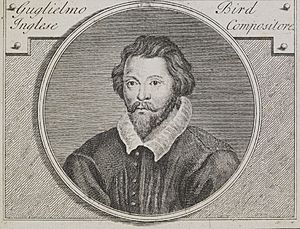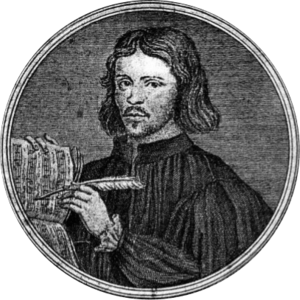Thomas Tallis facts for kids
Thomas Tallis (born around 1505 – died 23 November 1585) was a famous English composer. He wrote music during the Renaissance period. Most of his music was for singing, especially for choirs. Many people think Tallis was one of England's best composers. He is known for his unique style in English music.
Contents
Life of Thomas Tallis
His Early Life
We don't know much about Thomas Tallis's early life or where he came from. This is because there are no records of his birth or family. Historians believe he was born in the early 1500s, when King Henry VII was still ruling England. He might have been born in Kent, a county in England, because his family name and his cousin's name were common there.
Some people think Tallis sang as a boy in the Chapel Royal. This was the same singing group he joined when he was older. He was probably a choirboy at Dover Priory, a church in Dover, when he was young. He might also have sung at Canterbury Cathedral.
His Career as a Musician
Tallis worked as a composer and musician for four different English rulers. These were King Henry VIII, King Edward VI, Queen Mary I, and Queen Elizabeth I. He was an organist for most of his career.
Tallis was good at changing his music style to fit what each ruler wanted. This helped him stay out of trouble during the religious changes happening in England. He was a Roman Catholic, but he still served Protestant rulers. He was a very important composer, even more so than others like Christopher Tye. He was known for being more flexible and skilled in his music.
Tallis also taught other composers. One of his most famous students was William Byrd.
Working in the 1530s and 1540s
The first record of Tallis is from 1531. He was working as an organist at Dover Priory in Kent. He was paid £2 a year to lead chants from the organ. The priory closed in 1535, and we don't know when Tallis left.
After that, Tallis worked at St Mary-at-Hill in London. He was paid there from 1536 to 1538. He worked as either a singer or an organist.

In late 1538, Tallis moved to Waltham Abbey, a large church in Essex. He became a senior musician there. When this church closed in 1540, Tallis did not get a regular payment. Instead, he received a one-time payment of 40 shillings.
By the summer of 1540, Tallis was working at Canterbury Cathedral. He was the top singer in the choir, which had 10 boys and 12 men. He stayed there for two years.
Working for the Royal Family
Tallis likely started working for the Chapel Royal in 1543. This was the main musical group for the royal family. He claimed in 1577 that he had served the Queen and her family for 40 years. He might have taught the choir boys how to play keyboard and compose music.
Around 1552, Tallis got married to Joan. She was a widow whose first husband had also worked for the Chapel Royal. Tallis and his wife lived in Greenwich, like many other royal musicians. They probably rented a house there. They did not have any children.
Queen Mary I gave Tallis a special lease on land in Kent. This gave him a good income each year. He was at her funeral in 1558 and at Elizabeth I's coronation the next month.

Tallis was an important person in Queen Elizabeth's royal chapel. But as he got older, he became less active. In 1575, Queen Elizabeth gave Tallis and his student, William Byrd, a special right. For 21 years, only they could print and publish certain types of music. This was one of the first deals of its kind in England. They had the only right to print music in any language.
They published a collection of works called Cantiones quae ab argumento sacrae vocantur in 1575. But it did not sell well. They had to ask Queen Elizabeth for more help. People were careful about buying their new music, partly because both Tallis and Byrd were Roman Catholics. They were not allowed to sell music from other countries.
In 1577, they asked the Queen again for help. This time, she gave them a shared lease on some royal land. After the 1575 publication, Tallis likely stopped writing new music. No works from his last years have been found.
His Final Years
In his later life, Tallis lived in Greenwich, near the royal Palace of Placentia. He was still part of Queen Elizabeth I's household in June 1585. He wrote his will in August of that year. He died at his home in Greenwich on 20 or 23 November 1585.
He was buried in St Alfege Church, Greenwich. There was a special metal plaque there to remember him, but it is now lost. His remains might have been lost when the church was rebuilt in the 1710s.
William Byrd wrote a sad piece of music called Ye Sacred Muses when Tallis died. Tallis's wife, Joan, died almost four years after him.
Thomas Tallis's Music
His Early Music
Tallis's earliest surviving works include Ave Dei patris filia and Magnificat for four voices. He also wrote two songs for the Virgin Mary, Salve intemerata virgo and Ave rosa sine spinis. These were sung in the evening after church services.
When King Henry VIII broke away from the Roman Catholic Church in 1534, it changed music. The church leader, Thomas Cranmer, wanted music to be simpler. He wanted each syllable of a word to be sung to one note. This made Tallis's music less fancy. His Mass for Four Voices uses this simpler style, focusing on chords.
When King Edward VI became ruler (1547–53), he started the new Anglican church services. Tallis was one of the first musicians to write church songs in English. But Latin was still used too.
Queen Mary I became ruler in 1553. She brought back some older church traditions. Music became more elaborate again. Two of Tallis's big works from this time are Gaude gloriosa Dei Mater and the Christmas Mass Puer natus est nobis. These pieces were meant to honor the Queen and the Virgin Mary.
Some of Tallis's works were collected in a book called The Mulliner Book. This was before Queen Elizabeth's time. She might have used it when she was younger.
When Queen Elizabeth became ruler in 1558, the Book of Common Prayer became the main church book. Composers started writing English songs again. Tallis wrote nine psalm tunes for a book published in 1567. One of these tunes, the "Third Mode Melody," later inspired a famous piece by Ralph Vaughan Williams in 1910.
Tallis's setting of Psalm 67 is known as "Tallis's Canon." It was adapted for the hymn "All praise to thee, my God, this night." This is his most famous piece.
The church rules also allowed more complex music at certain times. Many of Tallis's more complex songs from Elizabeth's time might have been sung then. Or, families might have sung them at home. Some of his well-known works from this time include his Lamentations and the special song Spem in alium. This song is for eight choirs, each with five voices. It is what he is most remembered for.
His Later Music
Towards the end of his life, Tallis did not change his music style as much as younger composers like Byrd. He liked to use texts from the church services. He wrote music during a time of conflict between Catholicism and Protestantism. His music often shows signs of this struggle.
Thomas Tallis's Legacy
Tallis is mostly remembered for his church music for singing. This is because not much of his instrumental music or non-religious vocal music has survived.
There are no pictures of Tallis made when he was alive. The one by Gerard Vandergucht was painted 150 years after he died. So, we don't know if it looks like him. In his signature, he spelled his name "Tallys."
A made-up version of Thomas Tallis was played by Joe Van Moyland in the 2007 TV show The Tudors.
Images for kids
See also
 In Spanish: Thomas Tallis para niños
In Spanish: Thomas Tallis para niños





